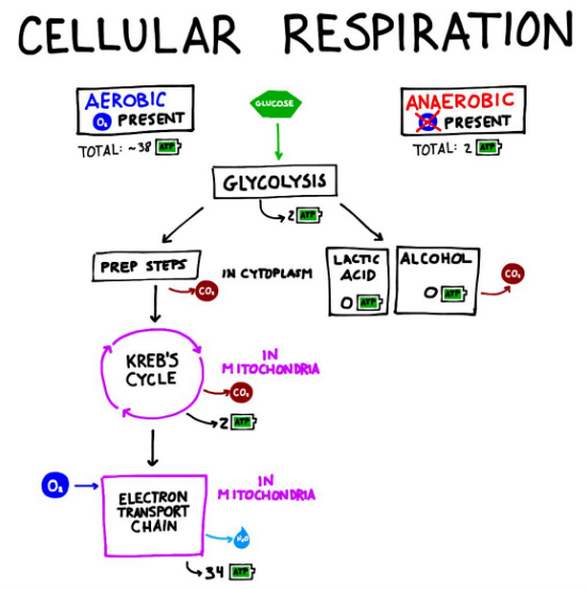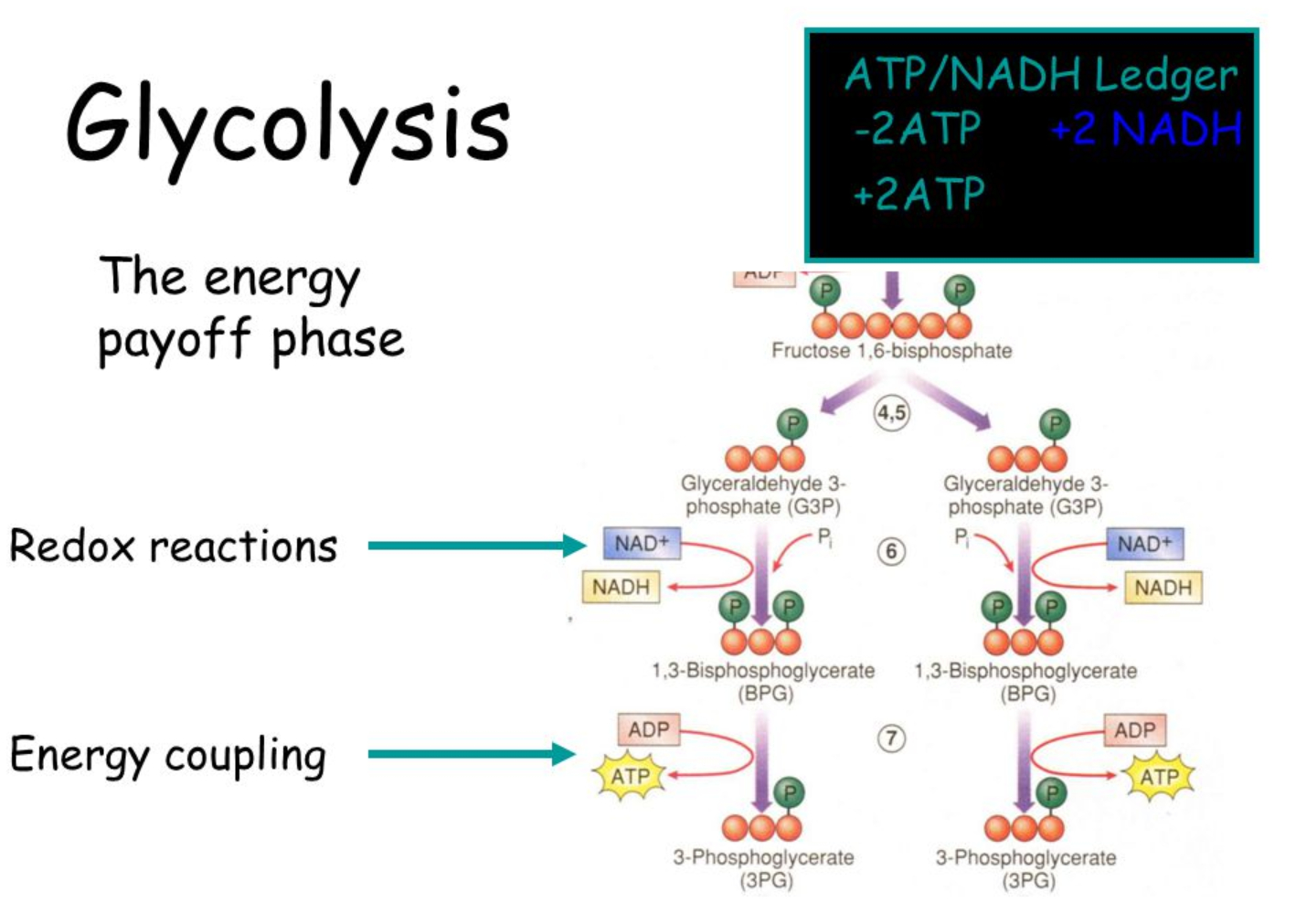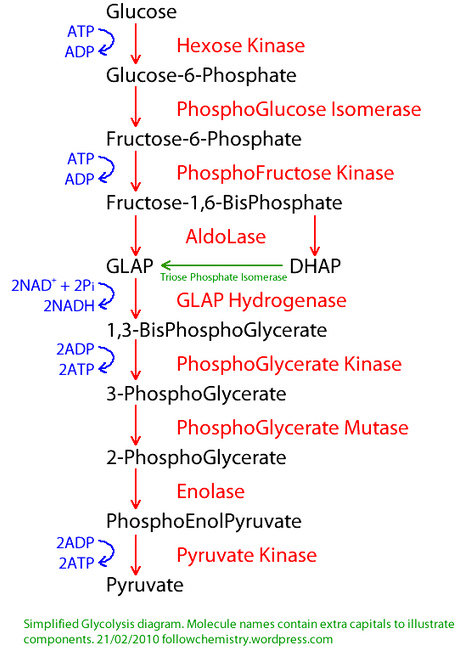Glycolysis Pathway – Definition and Summary
Last reviewed by Editorial Team on February 27th, 2019.
Definition
A glycolysis is a breakdown of glucose into pyruvate molecules and produced two ATP molecules. It is the initial phase of cellular respiration. The end product of glycolysis; pyruvate is used in either aerobic or anaerobic respiration. Pyruvate is helpful in the absence of oxygen and helpful in aerobic respiration through the TCA cycle. It means that the cells have more supply of energy.
A glycolysis is the first stage of cellular respiration. If there is no oxygen, glycolysis takes place to allow the cells to produce a small amount of ATP through fermentation. The process takes place in the cytoplasm, specifically in the cytosol. (1, 2, 3)

Image 1: The cellular respiration showing glycolysis in a diagram presentation.
Picture Source: i.stack.imgur.com

Picture 2: The process of glycolysis with emphasis on energy coupling and redox reactions.
Photo Source: images.slideplayer.com
What is the glycolysis cycle?
The glycolysis cycle can be separated into two phases: energy requiring and energy releasing phase. They are further discussed below:
What are the steps of glycolysis?

Photo 3: The glycolysis process.
Image Source: image.slidesharecdn.com
#1 – Energy-Requiring Phase/Energy Investment Phase
In this initial phase, the glucose molecule splits into pyruvates (two three-carbon molecules). This phase is also called the energy investment phase. The series of steps are as follows:
- The glucose is converted into glucose-6-phosphate with the aid of hexokinase. It uses only one ATP which is then converted to ADP.
- The conversion of glucose-6-phosphate into fructose-6-phosphate with the aid of phosphoglucose isomerase.
- Fructose-6-phosphate is converted into fructose-1, 6 – biphosphate with the aid of phosphofructokinase using only one ATP that will be converted into ADP.
- The chemical reaction is catalyzed by bisphosphate aldolase thereby converting fructose-1, 6 – biphosphate into three molecules of carbon DHAP (dihydroxyacetone phosphate) and glyceraldehyde-3-phosphate.
- The conversion of dihydroxyacetone phosphate is catalyzed by triosephosphate isomerase. The chemical reaction is reversible but the dihydroxyacetone phosphate is depleted overtime as the glyceraldehyde-3-phosphate jumps into the next glycolysis phase.
- The molecules of glucose are arranged to allow two phosphate groups to attach to it. Two ATP molecules are used for this reaction to take place forming fructose-1, 6-bisphosphate, which is an unstable molecule.
- The molecules split forming two three-carbon sugars and a phosphate group is attached to it namely the DHAP and the glyceraldehyde-3-phosphate. They will be converted so as to form glyceraldehyde-3-phosphate. (2, 3, 4, 5)
As you can see, an energy in the form of ATP is needed to form an unstable fructose molecule. That is why it is called the energy investment phase/energy-requiring phase.
#2 – Energy Releasing/Energy Payoff Phase

Image 4: The energy releasing pathways of glycolysis.
Picture Source: www.pharmaxchange.info
In this phase, the molecules of glyceraldehyde-3-phosphate are converted to three carbon sugar minus the phosphate group. It is called energy releasing phase because it releases energy as the molecules become stable.
It is possible by converting NAD to NADH and converting ADP to ATP. (5, 6)
The energy releasing phase includes the following:
- A redox reaction takes place converting glyceraldehyde-3-phosphate into 1, 3-bisphosphoglycerate. At the same time, it also releases H+ ion from NAD+ to form NADH.
- The 1, 3-bisphosphoglycerate is converted into 3-phosphoglycerate with the aid of Phosphoglycerate kinase. It also converts ADP to ATP.
- The 3-phosphoglycerate is converted into 2-phosphoglycerate with the help of phosphoglycerate mutase.
- The 2-phosphoglycerate is converted into phosphoenolpyruvate using enolase. A water molecule is released at the same time.
- The final step is to convert phosphoenolpyruvate into pyruvate using pyruvate kinase and at the same time converts adenosine diphosphate into adenosine triphosphate. (5 6, 7, 8)
Glycolysis Animation Video
What are the 3 products of glycolysis?
If all the steps mentioned above take place (both the energy-requiring and energy-releasing), then three products of glycolysis are formed. These are:
- Two ATP (adenosine triphosphate) molecules
- Two pyruvate molecules
- Two NADH molecules
If oxygen is present, the molecules of pyruvate can be broken down through oxidation in the cellular respiration. It takes place to form energy in the form of carbon dioxide and ATP.
Glucose is an important metabolite in human metabolism. The use, storage, and regeneration of glucose is a complex process.
Glycolysis is just the first step of glucose degradation. The purpose of glycolysis is to break down glucose to pyruvate and generation of ATP energy.
The complete oxidation of pyruvate forms more ATP, which is more beneficial to the cellular functions. (3, 9, 10)
To know the detailed step by step information on glycolysis, please see – Glycolysis Cycle Steps with Diagrams
References:
- http://hyperphysics.phy-astr.gsu.edu/hbase/Biology/glycolysis.html
- https://www.khanacademy.org/science/biology/cellular-respiration-and-fermentation/glycolysis/a/glycolysis
- https://en.wikipedia.org/wiki/Glycolysis
- http://watcut.uwaterloo.ca/webnotes/Metabolism/Glycolysis.html
- https://microbiologyinfo.com/glycolysis-10-steps-explained-steps-by-steps-with-diagram/
- https://courses.lumenlearning.com/wm-biology1/chapter/reading-glycolysis-2/
- https://www.sciencedirect.com/topics/biochemistry-genetics-and-molecular-biology/glycolysis
- https://www.biovision.com/glycolysis-pathway
- https://www.sparknotes.com/biology/cellrespiration/glycolysis/section1/
- https://www.thoughtco.com/steps-of-glycolysis-373394
Similar Posts:
- Glycolysis Cycle – Steps and Enzymes (with Diagrams) In-Detail
- Difference between Mitosis and Meiosis
- Difference between DNA and RNA
- Methyl Red Test
- Benedict’s Test
